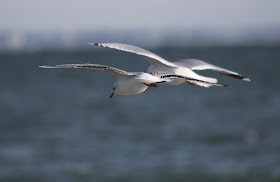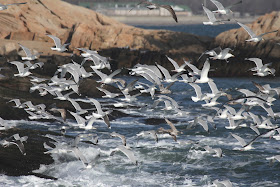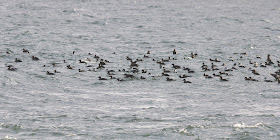Bountiful Day on the Sea in Rhode Island
Thursday, January, 19, 2012- I had planned on going on the cod boat Thursday morning, unfortunately, the trip was cancelled: not from the weather but not enough fisherman to go. So I decided to take the first ferry to Block Island, and then turn around on the first return trip back to
Block Island Ferry- outbound Galilee 6:30am- return Old Harbor 8:15 am. Winds N/NE 15 knots, temps 16 degrees at Galilee . There is no other way to put it but it was cold!! However with the following northerly wind offered a bit of relief, and there wasn’t any spray coming over the bow making the bow ride a bit more comfortable.
With the overcast morning, I was looking east with a bit brighter visibility and concentrating mostly on flying birds that were easier to spot. Just as we cleared the Harbor with minimal light, I could start to spot birds as they flew across the bow. Scoters and Eiders were most abundant…..
…..and handfuls of large Alcids (like this Razorbill), mostly singles were quite abundant within a mile from the outside of the sea walls.
The sea was covered with birds; difficult to identify and count everything. About halfway to Block, Kittiwake were buzzing by the ferry heading towards the Herring Trawlers farther to the east on the distant horizon.
When the ferry was east of the North Light, sea duck and sea bird numbers began to increase such as these White-winged Scoters…..
…..and this pair of Surf Scoters. (Juvenile drake on left, adult drake on right).
This Common Loon surfaced a few yards off the bow of the Ferry; it skittered across the sea to get out of its way!
As we passed by the outer green buoy east of Balls Point, and I started seeing larger concentrations and numbers of large Alcids both on the water and flying. Many were at a distance, but the birds that were closer appeared to have greater numbers of Common Murre in the flocks.
This small group of large Alcids flew in towards shore passing the green buoy just outside the mouth of Old Harbor. I followed the birds and they landed close to the shore off Crescent Beach
As the ferry passed between the breakwalls of Old Harbor, the large Cormorant and Gulls roosts were deserted. The birds had left the roost for their morning fishing forays farther out to sea. But the morning sky was worth a look or two.
Old Harbor, Block Island- After disembarking the ferry and a short walk around the docks and bulkhead, I was allowed to board the ferry, and I soon found myself back on the bow once again. The Harbor was very quiet; only the sounds of the fork truck loading and unloading the cargo from the ferry, and the calls of the Common Loons in the harbor were heard. I did have a front row seat to the bird show in the harbor though! There were many Red-breasted Mergansers in the Harbor flying in and out.
There were at least seven Common Loons in the Harbor, and many would surface and swim around the ferry, just below me. Interesting plumage on this Loon; note the rows of small dotted feather markings on top of its head.
Within a few minutes, the Great Cormorants began returning from the sea to their east breakwall roost.
A single Red-throated Loon landed in the Harbor and swam towards the ferry. It made a quick dive, and I couldn’t find it again.
This juvenile Common Loon “popped up” to the surface with its prey. At first I couldn’t identify what it had caught. Since the bird was feeding along the docks near the ferry, I thought it may have captured a Rock or Jonah Crab that might have been hanging on to one of the pilings. The Loon dropped the prey and had to dive again and try and catch it again.
When the bird returned to the surface with the prey, I saw that the Loon had captured a plate-sized Flounder!
The Loon struggled for at least ten minutes trying to figure out how to swallow the Flounder. It often made “stabbing” and “hammering” head thrusts at the fish……
……but it couldn’t manipulate the obviously larger fish to swallow it. The width of the fish was much wider than its gape……..
…..although it tried valiantly to swallow the Flounder; it gave up after many attempts.
This adult Loon swam alongside the Ferry and rose up in a wing stretch; this bird was in full wing moult….
……while this juvenile bird had complete wings.
As the Ferry horn sounded, we were underway. This pair of Common Eiders took off ahead of the Ferry…..and was fitted with a radio antenna. This is the second hen Eider I photographed this year with a fitted Radio Antenna on it (see my earlier report from Beavertail Point).
Passing by the Great Cormorants as we were leaving Old Harbor
….. and this drake White-winged Scoter flew across the bow.
As we were east of North Point, alcids again made their presence like this first pair of Dovekie showing their typically dark underwing feathering; an important fieldmark. (Razorbills, Murres and Black Guillemot have white underwings).
More large Alcids were concentrated in this area like this group of Razorbills and Common Murre.
It’s always a pleasure to watch Gannets; I never grow tired of them. A huge but elegant sea bird.
Kittiwake were more plentiful on the return trip appearing continually.
I was watching a single Kittiwake glide along the surface of the sea when suddenly it landed. Where the bird landed it joined another Kittiwake and a Bonaparte’s Gull that were sitting with a small group of Razorbills. Both Gull species were trying to steal fish from the Alcids when they returned to the surface.
There were many other Bonaparte’s Gulls flying around with the many Kittiwake. This one joined the Kittiwake keeping watch over the Razorbills.
This Bonaparte’s Gull exhibited unusually dark ventral primaries. When I first saw this bird it was at a distance in a small flock of Bonaparte’s Gulls. Its black underwings “flashed” like a blinking light. The bird appeared small or about the same size as a Bonaparte’s Gull, and my first thought was Little Gull. I took one or two images and the bird disappeared. When I reviewed the image in my camera LED screen (with watery eyes), it looked more like a Black-headed Gull because of its overall shape and pointed wings. But I kept telling myself that the bird was too small. When I was home examining the images on my laptop, it was obviously a Bonapartes Gull with unusual dark underwings.
The numbers of Alcids tapered off a bit when we were about two miles north of Block. However, when the Ferry was a few miles outside the outer seawalls of Point Judith, the Herring Trawlers were passing by heading west. With the Trawlers came an abundance of Alcids such as these…..
(From l to r)- Common Murre, juvenile Razorbill, juvenile Razorbill, adult Razorbill
This Red-necked Grebe passed by the bow heading east.
A flock of (dark-winged) Scoters followed by a large flock of large Alcids follow and pass this Herring Trawler.
A single Common Murre (at a distance)….
A single Common Murre (at a distance)….
….. a mixed flock of large Alcids…..
…..and a single Common Murre passes the Ferry at a closer distance…….
…..and this single Common Murre leads the Ferry to the gap in the Jerusalem
(Note- most of the Alcids were concentrated in two areas; to the east and north of Block Island, but the largest concentrations occurred within two miles of the Point Judith seawalls. All the Dovekie were in the area a little northeast of North Point, Block Island ).
The area near the seawalls of the
This flock or Purple Sandpipers (with one Ruddy Turnstone) landed on the outside of the center seawall.
I searched through all the Gulls in Galilee Harbor
After leaving Galilee, I drove over to Scarborough Beach
I walked back to the small jetty at the end of the beach (to position myself in better light for photographs) near the green water discharge. I had taken a small cooler full of catfood and cut up suet with me hoping to entice the Gulls to me. With the first few tosses of food, most of the Gulls cleared off the roost and came directly to the beach. The first group of Gulls (mostly Ring-billed) circled the suet on the beach. The Black-headed Gull was with this group.
They landed on the beach and began feasting on the suet and catfood. Here are a few images of the juvenile Black-headed Gull.
All the Gulls moved a few yards every few minutes (when the food was consumed) only to return with each tossed handful. Here are a few good flying images that are helpful for identification.
After a half an hour of visiting this fabulous Gull, I said good-bye and thanks and drove north to Newton Rock at the end of Newton Ave. I wanted to search through the Gull roost for any winter visiting Gull species. The Gull roost contained over three hundred birds which were coming and going as the distant Herring Trawlers passed by. I searched through as many Gulls as I could, but only found one “bird of interest”. The Gull was facing me at a slight angle with its head down resting. It resembled a second winter Lesser Black-backed Gull, but with later photo examination, was not.
The Trawlers were at a greater distance from shore on Thursday, but they still attracted swarms of seabirds.
Looking over to the northeast was Beavertail Point, and some of the trawlers appeared to be closer to the Point. Leaving Newton Ave., I passed under the Coast Guard House and spotted a small flock of feeding Bonaparte’s Gulls feeding along the town beach in the corner below the sea wall. Maybe there would be a Little Gull with them? I watched the feeding Bonaparte’s Gulls for fifteen minutes….I really love these dainty smaller Gulls!
Beavertail Point had the usual sea duck species including twenty-six Harlequin Ducks.
I drove back to Narragansett stopping at Camp Cronin
On the way home I stopped off to Ninigret Park
The Gull lifted off the water and landed closer in front of me.
It swam around for a few minutes drifting back and forth. It was looking for food in the shallow water near the edge of the cove, It would occasionally look down under the water until it spotted something….
……it would lift up and pounce downward reaching underwater revealing its yellow ochre legs and feet.
This next image is a good lesson why we should never assume a species is as it appears. Many factors can alter the look including bright sunlight. We should always re-evaluate and study every bird we see! This Gull appeared to have a very light grey mantle color because of the bright afternoon sun. In this image it looks like a Herring Gull.
But looks what happens when this Gull turns with more favorable light. Its mantle suddenly changes and is darker; the proper color for a Lesser Black-backed Gull.
The Gull eventually flew over the Point to the eastern Cove. With the correct light angle, you can now see its features: mid to dark grey mantle color, yellow legs, and long narrower wings and small white “windows” at the end of the wing.
This female Kingfisher was flying back across the Cove while I was watching the Gull.
After saying good-bye to the Gull, my next to the last stop was the Charlestown
A drake Red-breasted Merganser joins the Eider raft.......
.....as well as this drake White-winged Scoter that flew down and out of the Canal Breachway.
Also present was this pair of drake Oldsquaw.
Outside fly bys include eleven Gannets, three Bonaparte's Gulls and a single Black-legged Kittiwake heading east. The usual Common Loons, a few Red-throated Loons and Horned Grebes were present. This Common Loon fights the strong incoming tidal current in the breachway.
Keith Mueller
Rough estimates:
Large Alcids- (birds were mostly at a distance on
the way over-but it appeared to favor higher numbers of Common Murre) Large Alcids-
85-100
the way over-but it appeared to favor higher numbers of Common Murre) Large Alcids-
85-100
Dovekie- 13 (return trip)
Red-necked Grebe-1 east of Block
Black-legged Kittiwake- 23 (they were seen in both directions)
Red-necked Grebe- 1
Bonaparte's Gulls- 15
Great Cormorants- 28
Common Loons- 40 +/-
Gannets- (hundreds-mostly following offshore Trawlers, 25 on Ferry ride)
Red–throated Loons- 5
Large raft of mostly Eiders and Scoters (400+/-) in the mouth of the western opening of the Point Judith walls including 3 Oldsquaw.
Purple Sandpiper- 21 (including 1 Ruddy Turnstone) same location.
Black-headed Gull- 1 (first winter)
Bonaparte's Gulls- 7 (Narragansett Town Beach
Usual sea ducks in smaller numbers, 26 Harlequin Ducks mostly on the east shore near the northernmost point at Beavertail.
Point Judith, Camp Cronin- Large groups of sea ducks (mostly eider),
Razorbill-1, feeding along the outer edge of the east wall. Harriers-2
hunting along the beach and over the marshes.
Red-breasted Mergansers-38 chasing schooling fish around the dock area inGalilee Harbor
Lesser Black-backed Gull continues around grassy point Ninigret Park.
Bonaparte's Gulls- 7 (
Usual sea ducks in smaller numbers, 26 Harlequin Ducks mostly on the east shore near the northernmost point at Beavertail.
Point Judith, Camp Cronin- Large groups of sea ducks (mostly eider),
Razorbill-1, feeding along the outer edge of the east wall. Harriers-2
hunting along the beach and over the marshes.
Red-breasted Mergansers-38 chasing schooling fish around the dock area in
Lesser Black-backed Gull continues around grassy point Ninigret Park.
Yellow-rumped Warblers-3,
Belted Kingfisher (female)-1
Charlestown Breachway-Big raft of Common Eider (300+)(6 Black Scoter)
rafted up along the beach on both sides of each jetty, in the breachway itself and just outside.
Charlestown Breachway-Big raft of Common Eider (300+)(6 Black Scoter)
rafted up along the beach on both sides of each jetty, in the breachway itself and just outside.
Bonaparte's Gulls- 3 and Black-legged Kittiwake flying by heading east (same location).
The usual Common Loons, a few Red-throated Loons and Horned Grebes present.
Quonochontaug Breachway, the usual Common Eiders and Loons.
Yellow-rumped Warbler-1
Quonochontaug Breachway, the usual Common Eiders and Loons.
Yellow-rumped Warbler-1































































































































































































































